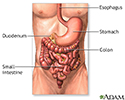Stools - foul smelling
Foul-smelling stools; Malodorous stoolsFoul-smelling stools are stools with a very bad odor. They very often have to do with what you eat, but may be a sign of a medical condition.
Considerations
Stools normally have an unpleasant odor. Most of the time, the odor is familiar. Stools that have an extremely bad, abnormal odor may be due to certain medical conditions. Foul-smelling stools also have normal causes, such as diet changes.
Causes
Causes may include:
-
Celiac disease (also called celiac sprue)
Celiac disease
Celiac disease is an autoimmune condition that damages the lining of the small intestine. This damage comes from a reaction to eating gluten. This ...
 ImageRead Article Now Book Mark Article
ImageRead Article Now Book Mark Article -
Crohn disease
Crohn disease
Crohn disease is a disease where parts of the digestive tract become inflamed. It most often involves the lower end of the small intestine and the be...
 ImageRead Article Now Book Mark Article
ImageRead Article Now Book Mark Article -
Ulcerative colitis
Ulcerative colitis
Ulcerative colitis is a condition in which the lining of the large intestine (colon) and rectum become inflamed. It is a form of inflammatory bowel ...
 ImageRead Article Now Book Mark Article
ImageRead Article Now Book Mark Article -
Chronic pancreatitis
Chronic pancreatitis
Pancreatitis is swelling of the pancreas. Chronic pancreatitis is present when this problem does not heal or recurs and does not improve, gets worse...
 ImageRead Article Now Book Mark Article
ImageRead Article Now Book Mark Article -
Cystic fibrosis
Cystic fibrosis
Cystic fibrosis is a disease that causes thick, sticky mucus to build up in the lungs, digestive tract, and other areas of the body. It is one of th...
 ImageRead Article Now Book Mark Article
ImageRead Article Now Book Mark Article - Intestinal infection
-
Malabsorption
Malabsorption
Malabsorption involves problems with the body's ability to take in (absorb) nutrients from food.
 ImageRead Article Now Book Mark Article
ImageRead Article Now Book Mark Article -
Short bowel syndrome
Short bowel syndrome
Short bowel syndrome is a problem that occurs when part of the small intestine is missing or has been removed during surgery. Nutrients are not prop...
 ImageRead Article Now Book Mark Article
ImageRead Article Now Book Mark Article - Blood in stool from stomach or intestine
Home Care
Home care depends on what is causing the problem. Things you can do include:
- Follow your health care provider's instructions.
- If you have been given a special diet, stick to it closely.
- If you have diarrhea, drink more fluids so you do not get dehydrated.
When to Contact a Medical Professional
Contact your provider if you have:
- Black or pale stools often
- Blood in the stool
- Changes in the stool related to diet
- Chills
- Cramping
- Fever
- Pain in the abdomen
- Weight loss
What to Expect at Your Office Visit
Your provider will perform a physical exam and ask about your medical history. Questions may include:
- When did you first notice the change?
- Are your stools an abnormal color (such as pale or clay-colored stools)?
Pale or clay-colored stools
Stools that are pale, clay, or putty-colored may be due to problems in the biliary system. The biliary system is the drainage system of the gallblad...
 ImageRead Article Now Book Mark Article
ImageRead Article Now Book Mark Article - Are your stools black (melena)?
- Are your stools hard to flush?
- What sort of diet have you eaten recently?
- Does a change in your diet make the smell worse or better?
- What other symptoms do you have?
The provider may take a stool sample. Other tests may be needed.
References
Höegenauer C, Hammer HF. Maldigestion and malabsorption. In: Feldman M, Friedman LS, Brandt LJ, eds. Sleisenger and Fordtran's Gastrointestinal and Liver Disease. 11th ed. Philadelphia, PA: Elsevier; 2021:chap 104.
Semrad CE. Approach to the patient with diarrhea and malabsorption. In: Goldman L, Cooney KA, eds. Goldman-Cecil Medicine. 27th ed. Philadelphia, PA: Elsevier; 2024:chap 126.
-
Lower digestive anatomy - illustration
Food passes from the stomach into the small intestine. In the small intestine all nutrient absorption occurs. Whatever has not been absorbed by the small intestine passes into the colon. In the colon most of the water is absorbed from the food residue. The residue is then eliminated from the body as feces.
Lower digestive anatomy
illustration
-
Lower digestive anatomy - illustration
Food passes from the stomach into the small intestine. In the small intestine all nutrient absorption occurs. Whatever has not been absorbed by the small intestine passes into the colon. In the colon most of the water is absorbed from the food residue. The residue is then eliminated from the body as feces.
Lower digestive anatomy
illustration
Review Date: 8/12/2024
Reviewed By: Jenifer K. Lehrer, MD, Gastroenterologist, Philadelphia, PA. Review provided by VeriMed Healthcare Network. Also reviewed by David C. Dugdale, MD, Medical Director, Brenda Conaway, Editorial Director, and the A.D.A.M. Editorial team.



